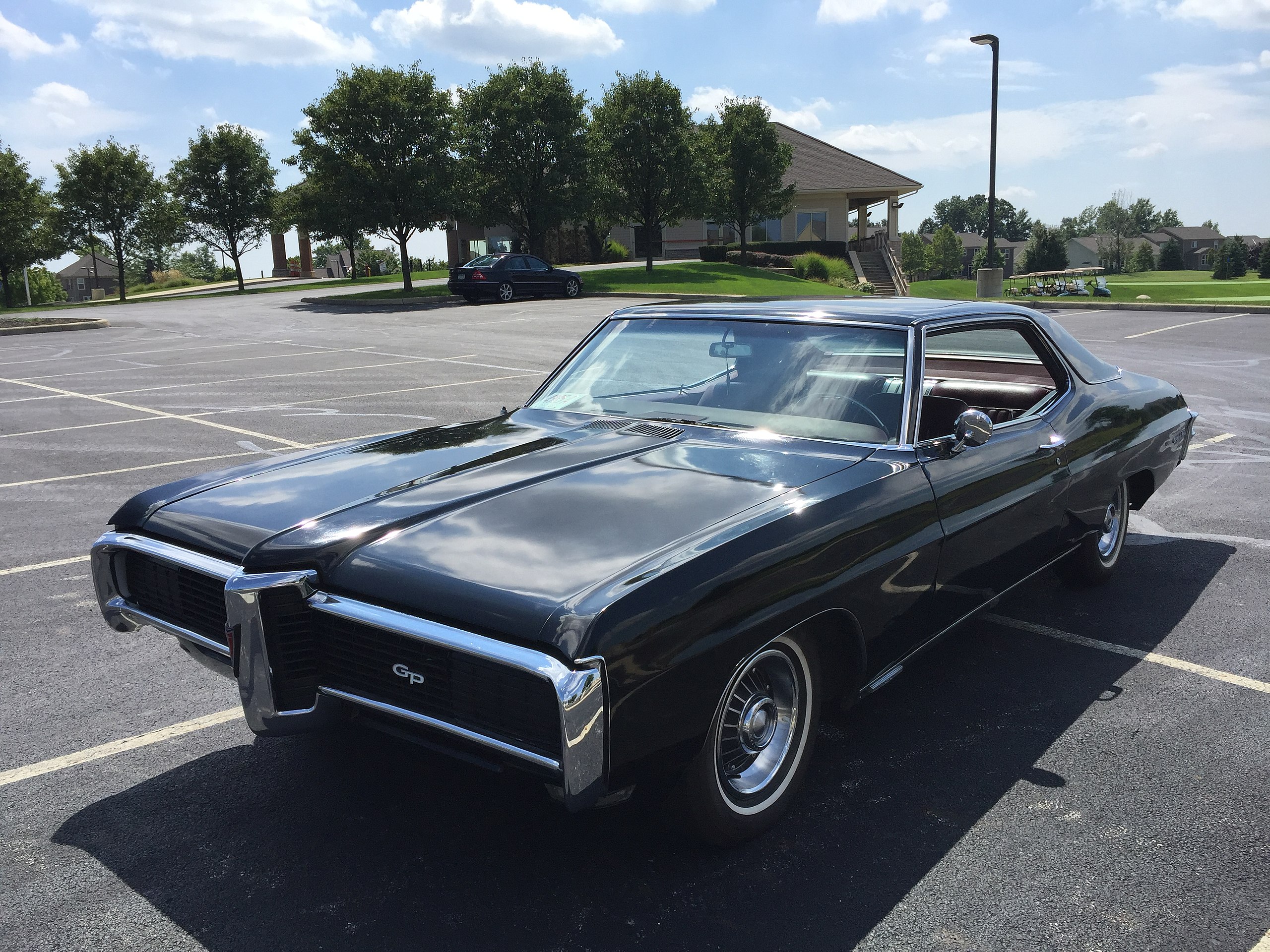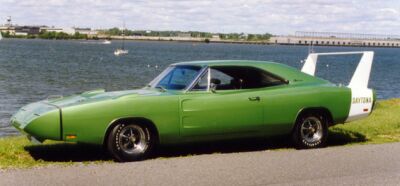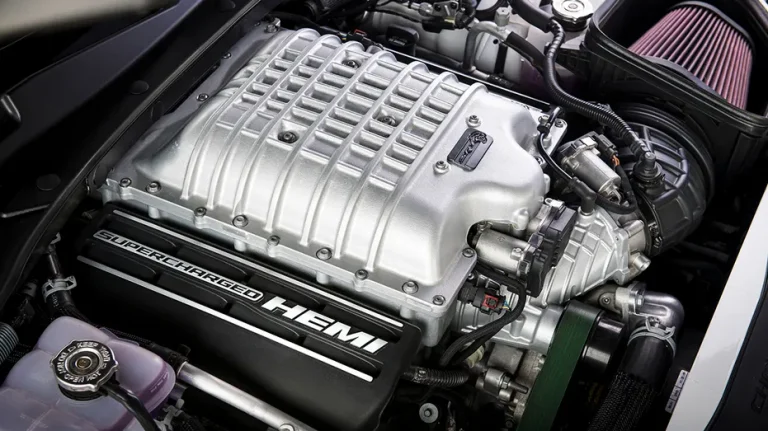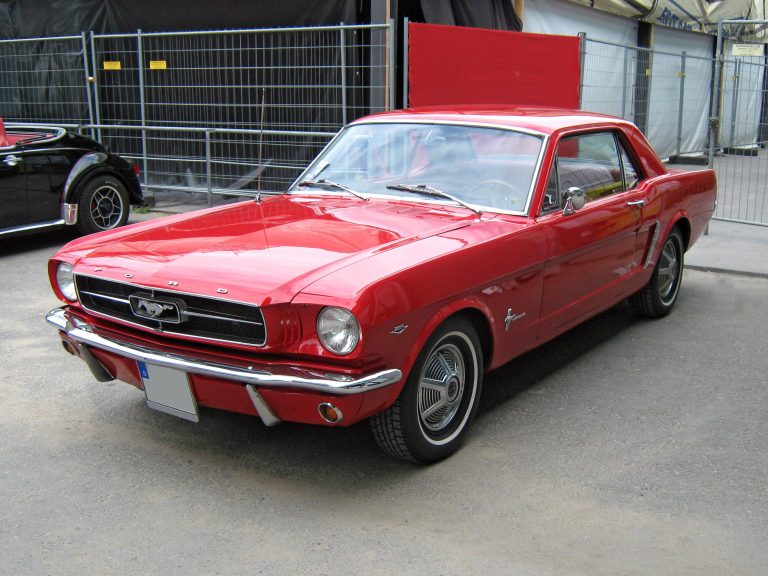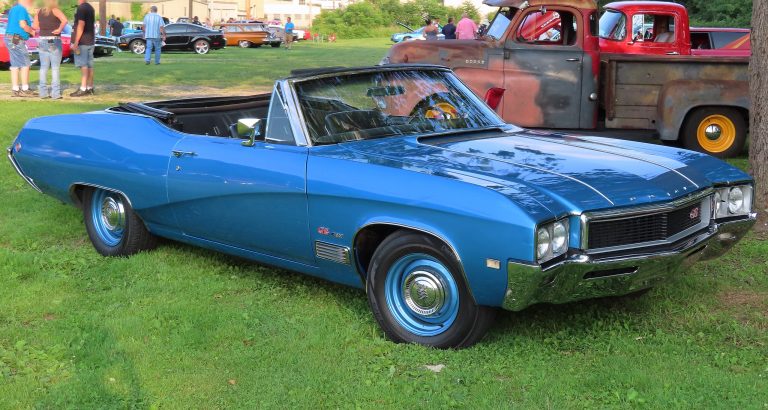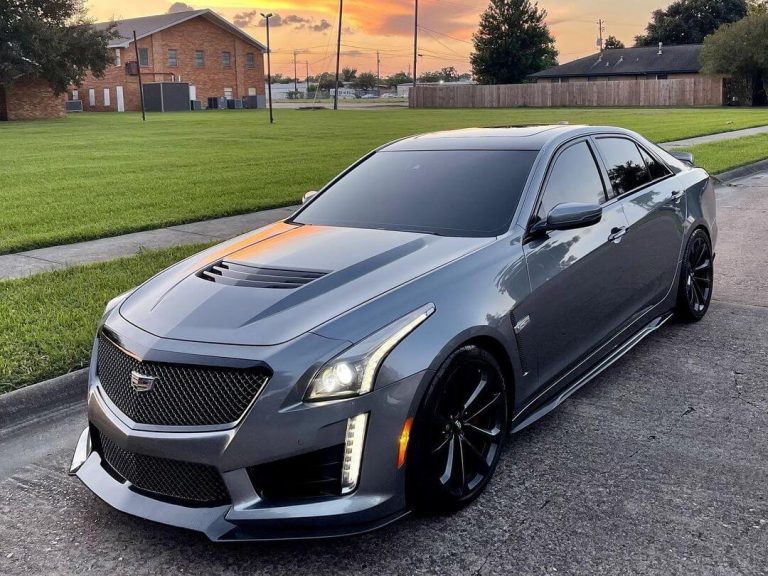Pontiac Grand Prix

Meet Chandler
Chandler has a bachelors and masters degree in history as well as a passion for classics and muscle cars. His education and historical knowledge makes him skilled at crafting highly detailed articles about America’s muscle cars and automotive history. His love of muscle cars is undeniable, with him seeking them out at every opportunity during his visits to auto shows and car meets. Chandler’s knowledge and enthusiasm towards automotive history make him a great asset to the Muscle Car Club community.
The Pontiac Grand Prix was one of the most popular cars in the General Motors lineup for more than four decades from 1962–2008. The Grand Prix started out as a full sized rear-wheel drive coupe, riding the wave of 1960s muscle cars but for the luxury market. It eventually evolved from personal luxury and ended life as a mid-sized sedan with front-wheel drive. During its lifespan, Pontiac sold more than 4.2 million Grand Prix, reaching a high water mark of more than 288,000 in 1977.
Pontiac Grand Prix Overview
The Pontiac Grand Prix lasted for a total of 47 model years from 1962–2008. From 1962–2002 it was available as a coupe, and from 1990–2008 it was available as a sedan, too. For one year only in 1967, a convertible was available, but it was unpopular and sold poorly. Pontiac discontinued the Grand Prix in 2008 in favor of the new G8 sedan, and the Pontiac brand officially ended production in 2010.
The first generation of the Grand Prix lasted from 1962–1964. Available engines were either 389 cid or 421 cid V8s making 230–370 horsepower and 380–460 lb-ft of torque. It was a full-sized performance and luxury grand tourer and only available as a two-door hardtop coupe. Pontiac based it largely on the Catalina, including giving it the same GM B-body platform.
The second generation Pontiac Grand Prix lasted from 1965–1968, and performance increased even more. The 389 and 421 V8s lasted until 1966, when they were replaced by larger 400 cid and 428 cid V8s, respectively. Horsepower was about the same, but enthusiasm and sales actually declined in the middle of the production cycle. The Grand Prix still rode on the same B-body platform, and for one year in 1967 a convertible was available.
The third generation of the Pontiac Grand Prix lasted from 1969–1972, and it transitioned from the B-body to the new G-body platform. It was now a mid-sized grand tourer instead of a full-sized. Engine-wise, the Grand Prix reached a peak in 1969 with the 428 cid V8 making 390 horsepower and 465 lb-ft of torque. However, things took a sharp downturn, as emissions and the switch from SAE Gross to SAE Net power ratings dropped the Grand Prix to just 200–250 horsepower by 1972.
The Fourth Generation Begins
The fourth generation of the Grand Prix lasted from 1973–1977, and the car moved to the GM A-body “Special” platform. Power was down considerably this generation from 1974 on, but sales started to increase dramatically. 1977 was the most purchased Grand Prix ever with more than 288,000 sold.
The fifth generation Grand Prix was from 1978–1987, and it started on the A-body platform but moved to the G-body in 1982. After previously only using V8 engines, in 1980 a 3.8 L V6 was available for the first time, followed by a 350 cid V8 diesel in 1981. In 1987, the first Grand Prix with electronic fuel injection was available, through a 4.3 L V6. Unfortunately, after ending the ‘70s on a high note, production declined by more than 90% from 1978–1987.
The sixth generation of the Pontiac Grand Prix lasted from 1987–1996, and saw a major transformation as it switched to the W-body and became front-wheel drive. A sedan version was introduced starting in 1990. In addition, all of the V8s were dropped in favor of smaller V6s. The Grand Prix got its first turbo from 1989–1990, feeding a 3.1 L V6 and making 205 horsepower. In 1990, the first 2.3 L inline-four based Grand Prix was introduced at 160 horsepower.
The Final Generations
The seventh and penultimate generation of the Grand Prix lasted from 1997–2004. The highlight was the 3.8 L supercharged V6 that made 240 horsepower and 280 lb-ft of torque. The Grand Prix still resided on the W-body, now in its second generation, and was available from 1997–2002 as either a coupe or sedan. In 2003, Pontiac eliminated the coupe as an option for the first time in Grand Prix history, leaving only the sedan bodystyle available.
The eighth and final generation of the Grand Prix lasted from 2004–2008, with it using the third generation of the W-body platform. The 3.8 L supercharged V6 was carried over but now made 260 horsepower. However, the top dog was the 5.3L LS4 V8 that made 303 horsepower and 323 lb-ft of torque. 2008 was the last model year of the Grand Prix, as it would be succeeded by the Pontiac G8 for 2009.
First Generation Pontiac Grand Prix
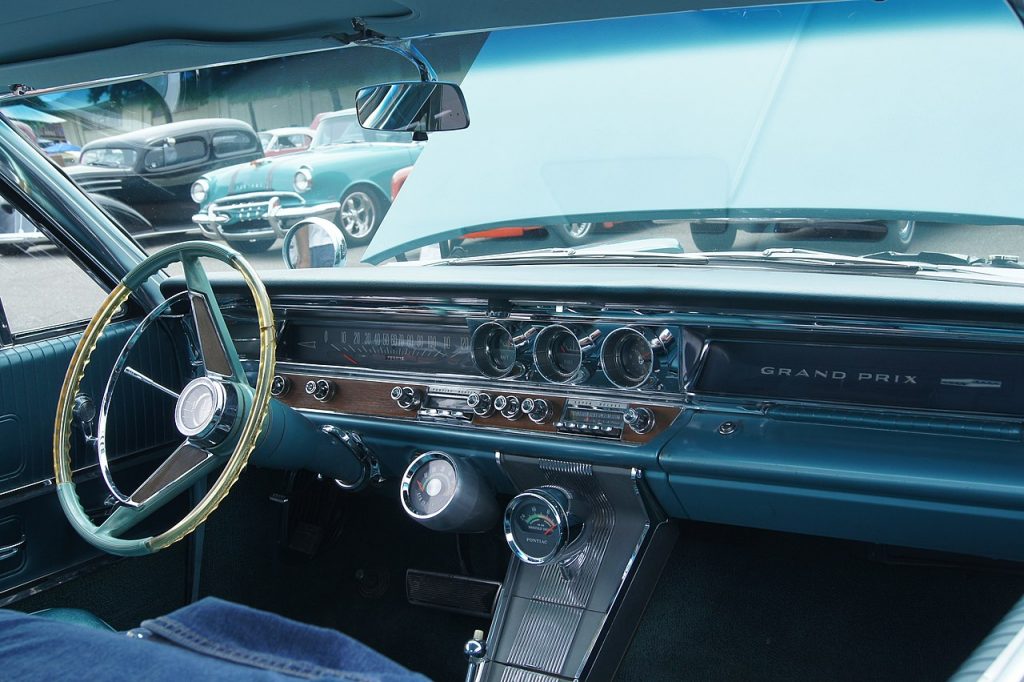
The first generation of the Pontiac Grand Prix lasted from 1962–1964 and was known internally as the “Series 28” (1962) and “Series 29” (1963–1964). The idea for the Grand Prix was drawn from the late-’50s Pontiac Bonneville, and it debuted for the 1962 model year. It shared the same General Motors B-body as the Catalina/Ventura, but had a somewhat dialed down exterior and was in a two-door hardtop coupe body style. The Grand Prix also sat a bit lower than its Pontiac brethren by a full inch.
The 1962 Grand Prix could be distinguished by the checkered flag badge inside the grille and unique rear end with full molding. The interior was tastefully refined, with durable and appealing Morrokide bucket seats, a floor-shifter, and a tachometer. The 1963 Pontiac Grand Prix changes included Grand Prix badges behind the enclosed and stacked headlights, grilled-over taillights, and like the year before was sold with everything that was standard in the Bonneville.
The 1964 Pontiac Grand Prix got new badges on the fender and inside the grille. Dual exhausts and bucket seats were standard, and wood-grained trim was available for the interior – same as the year before. The grille had horizontal slants, and some chrome was removed, too.
First Generation Engine Technical Specifications
| Model Years | Engine | Horsepower | Torque |
| 1962-1964 | 389 cid V8 (2bbl) | 230 horsepower | 380 lb-ft |
| 1962-1963 | 389 cid V8 (4bbl) | 235 horsepower | 386 lb-ft |
| 1962-1964 | 389 cid V8 (4bbl) | 303 horsepower | 425 lb-ft |
| 1962 | 389 cid V8 (425A Tri-Power) | 318 horsepower | 430 lb-ft |
| 1962 | 389 cid V8 (425A Tri-Power) | 333 horsepower | 425 lb-ft |
| 1962 | 389 cid V8 (425A Tri-Power) | 348 horsepower | 430 lb-ft |
| 1962 | 421 cid V8 (SD 2x4bbl) | 405 horsepower | 425 lb-ft |
| 1963 | 389 cid V8 (425A Tri-Power) | 313 horsepower | 430 lb-ft |
| 1963 | 421 cid V8 (4bbl) | 353 horsepower | 455 lb-ft |
| 1963-1964 | 421 cid V8 HO (Tri-Power) | 370 horsepower | 460 lb-ft |
| 1964 | 389 cid V8 (4bbl) | 255 horsepower | 400 lb-ft |
| 1964 | 421 cid V8 (4bbl) | 320 horsepower | 455 lb-ft |
| 1964 | 389 cid V8 (Tri-Power) | 330 horsepower | 430 lb-ft |
| 1964 | 421 cid V8 (Tri-Power) | 350 horsepower | 454 lb-ft |
First Generation Engines, Transmissions, and Performance
For the inaugural year of the 1962 Grand Prix, Pontiac had just one engine size available: A 389 cid V8. However, it was available in a number of power outputs, ranging from the pedestrian 230 horsepower economy, to the 348 horsepower 425A version with the Tri-Power carburetor. The Tri-Power carb was three Rochester double-barrel carbs put together to make a six-barrel unit.
In addition to the larger carb, the 425A versions of the 389 V8 had beefed up blocks with four-bolt mains and a more aggressive camshaft. These were known as the Trophy engines, and enjoyed a solid reputation. Pontiac also reportedly put in the 421 cid Super Duty V8 that had a forged-steel crankshaft and connecting rods.
For the carburetor, Pontiac strapped together a pair of four-barrel carburetors to make an eight-barrel behemoth. This was only put in a few 1962 Grand Prix, and was not a factory option. It reportedly made 405 horsepower and 425 lb-ft of torque, which would make it the most powerful Grand Prix of all time.
In the 1963 Grand Prix, a less powerful version of the 421 V8 with just a single four-barrel was put into production. A high-output (HO) version that made 17 more horsepower was available from 1963–1964. Various 389 and 421 V8s were options with double, quad, or Tri-Power carbs from ‘62–’64.
Available transmissions were either a 3-speed or 4-speed manual, or a 3-speed automatic Hydra-Matic. In 1962, the top of the line 389 V8 with 370 horsepower could go from zero to 60 mph in 6.6 seconds, with a ¼ mile time of 15.1 seconds @ 95 mph.
First Generation Pontiac Grand Prix Production Numbers
| Model Year | Bodystyle | Production Total |
| 1962 | Hardtop Coupe | 30,195 |
| 1963 | Hardtop Coupe | 72,959 |
| 1964 | Hardtop Coupe | 63,810 |
| 1962-1964 | Total Production | 166,964 |
The first year of the Pontiac Grand Prix sold relatively well, covering just over 30,000 units. Production more than doubled the next year in 1963, and stayed relatively steady for 1964, too. Overall, the first generation Grand Prix was a very successful car for Pontiac.
Second Generation Pontiac Grand Prix
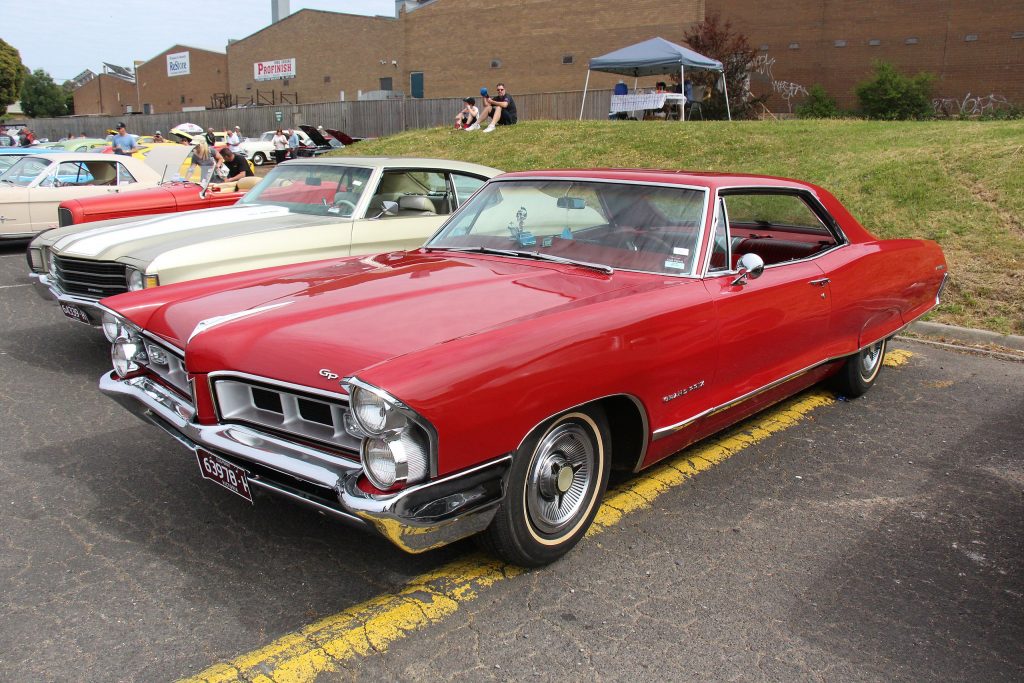
The second generation of the Pontiac Grand Prix lasted from 1965–1968, and the Grand Prix was now the “Series 266” internally. The 1965 Pontiac Grand Prix was newly restyled with the famous “coke bottle” look, but stayed as a two-door coupe. New was a vertically divided air slot grille, as well as “GP” badges on the left-hand side of the hood. Bench seats were optional and bucket seats were standard, with Morrokide upholstery still available. In 1966, new Strato Buckets seats were available and fender skirts were added.
For 1967 only, Pontiac made available a convertible body style to go along with the hardtop coupe. Unfortunately, it sold very poorly and was not continued for 1968. Also for 1967, was new GP badging in the grille, hide-away headlights, and the Strato buckets seats remained an option. In the convertibles, Pontiac put GP initials on the glass window.
For the 1968 Pontiac Grand Prix , all GM safety features were standard, in addition dual exhausts, deluxe wheel discs, center console, and contoured and padded bucket seats. 1968 was the final year of the Series 266 or second generation Grand Prix.
Second Generation Engine Technical Specifications
| Model Years | Engine | Horsepower | Torque |
| 1965-1968 | 389 cid V8 (4bbl) | 256 horsepower | 288 lb-ft |
| 1965 | 389 cid V8 (4bbl) | 303 horsepower | 425 lb-ft |
| 1965-1966 | 389 cid V8 (4bbl) | 325 horsepower | 429 lb-ft |
| 1965-1966 | 389 cid V8 (4bbl) | 333 horsepower | 429 lb-ft |
| 1965 | 389 cid V8 (Tri-Power) | 338 horsepower | 433 lb-ft |
| 1965-1966 | 421 cid V8 (4bbl) | 338 horsepower | 459 lb-ft |
| 1965-1966 | 421 cid V8 HO (Tri-Power) | 356 horsepower | 459 lb-ft |
| 1965-1966 | 421 cid V8 HO (Tri-Power) | 376 horsepower | 460 lb-ft |
| 1967 | 400 cid V8 (4bbl) | 265 horsepower | 397 lb-ft |
| 1967-1968 | 400 cid V8 (4bbl) | 350 horsepower | 440 lb-ft |
| 1967 | 428 cid V8 (4bbl) | 360 horsepower | 472 lb-ft |
| 1967-1968 | 428 cid V8 (4bbl) | 375 horsepower | 462 lb-ft |
| 1968 | 428 cid V8 (4bbl) | 390 horsepower | 465 lb-ft |
Second Generation Engines, Transmission Options, and Performance
For 1965, Pontiac carried over the 389 and 421 V8s, with the most powerful being the Tri-Power carburetor versions. The 389 Tri-power made 338 horsepower, while the 421 Tri-Power made either 356 horsepower or 370 horsepower.
For 1967, Pontiac dropped both the 389 and 421 V8s in favor of the slightly larger 400 and 428 cid V8s. Also gone was the Tri-Power carb option. The 400 V8 used a four-barrel carb and could make either 265/350 horsepower, and the 428 V8 also used a four-barrel carb and could make either 360 or 370 horsepower. In 1968, a 390 horsepower version was made available, which is the most powerful production Grand Prix of all time.
Transmission options remained stable with either a 3-speed or 4-speed manual or a 3-speed automatic, but they were different models. The manuals were both synchromesh, and the automatic was a new version of the Turbo Hydra-Matic.
The 1965 Grand Prix was voted car of the year by Motor Trend.
Second Generation Pontiac Grand Prix Production Numbers
| Model Year | Bodystyle | Production Total |
| 1965 | Hardtop Coupe | 57,881 |
| 1966 | Hardtop Coupe | 36,757 |
| 1967 | Hardtop Coupe | 37,125 |
| 1967 | Convertible Coupe | 5,856 |
| 1967 Total | 42,981 | |
| 1968 | Hardtop Coupe | 31,711 |
| 1965-1968 | Total Production | 169,330 |
The second generation of the Pontiac Grand Prix saw declining sales compared with the first generation. It sold less than 3,000 more in four years than the Series 28/29 sold in three years – and this was after it had already been established on the market. The 1967 convertible sold so poorly Pontiac did not even give it a chance at a second year.
Third Generation Pontiac Grand Prix
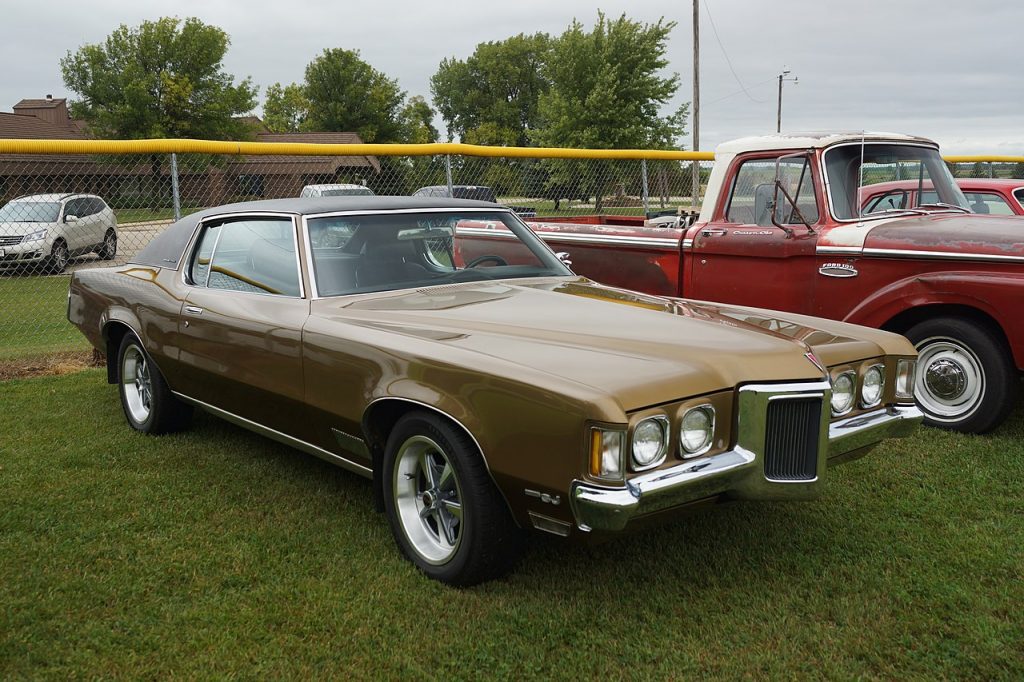
The third generation of the Grand Prix lasted from 1969–1972, and got another new internal designation. For 1969, the Series 266 became the Series 276, which would change to the Series 2K for 1972. The big external change was the switch from the full-sized B-body to the new mid-sized G-body platform. The new version had a shorter wheelbase combined with an exceptionally long hood, and it remained a two-door hardtop coupe.
For 1969, the “SJ” option package was introduced, which was essentially a luxury package over the standard “J” trim. 1970 saw some minor restylings, with the “SJ” trim still being offered. For 1971, the headlights were now single, and either bench or bucket seats were available. Deluxe wheel covers and power brakes were made standard.
In the final year of 1972, the Grand Prix got high-intensity single headlights, cross-hatched grilles, and a new rear end with new tail lights. The “SJ” option was still available, and included a bigger engine, rally gauge cluster, vinyl pinstripes, and more.
Third Generation Engine Technical Specifications
| Model Years | Engine | Horsepower | Torque |
| 1969-1970 | 400 cid V8 (2bbl) | 265 horsepower | 397 lb-ft |
| 1969-1970 | 400 cid V8 (4bbl) | 350 horsepower | 445 lb-ft |
| 1969 | 400 cid V8 (4bbl) | 360 horsepower | 472 lb-ft |
| 1969 | 428 cid V8 (4bbl) | 370 horsepower | 472 lb-ft |
| 1969 | 428 cid V8 (4bbl) | 390 horsepower | 465 lb-ft |
| 1970 | 455 cid V8 (4bbl) | 370 horsepower | 500 lb-ft |
| 1971 | 400 cid V8 (4bbl) | 300 horsepower | 461 lb-ft |
| 1971 | 455 cid V8 (4bbl) | 325 horsepower | 455 lb-ft |
| 1972 | 400 cid V8 (4bbl) | 200 horsepower | 300 lb-ft |
| 1972 | 400 cid V8 (4bbl) | 250 horsepower | 325 lb-ft |
| 1972 | 455 cid V8 (4bbl) | 250 horsepower | 375 lb-ft |
Third Generation Engines, Transmission Options, and Performance
Both the 400 and 428 cid V8s carried over from Series 266 with the same power outputs. In 1970, the 428 was dropped for good, replaced with a larger 455 cid V8. Unfortunately, emissions and fuel economy concerns would start to deprive the Grand Prix of performance starting in 1971. That year, Pontiac (and all U.S. manufacturers) had to start listing horsepower and torque with both SAE Gross and SAE Net calculations.
SAE Gross had been the standard for reporting performance, but in 1971 SAE Net came along. SAE Net gives more accurate calculations for the engine, as they account for parasitic drivetrain and accessory loss. However, marketing wise it was a hard sell. For example, in 1971, the 455 V8 made 325 horsepower and 455 lb-ft Gross. But Net, the same engine rates at 260 horsepower and 380 lb-ft of torque.
For 1972, only Net figures were to be given, so consumers could not even see the Gross ratings. So while the 1972 versions of 400 and 455 V8s were not substantially changed from the prior year, they had radically worse performance on paper. The 455 could still pump out a healthy 375 lb-ft of torque (Net), though, so it could get off the line very well.
Third Generation Pontiac Grand Prix Production Numbers
| Model Year | Bodystyle | Production Total |
| 1969 | Hardtop Coupe | 112,486 |
| 1970 | Hardtop Coupe | 65,750 |
| 1971 | Hardtop Coupe | 58,325 |
| 1972 | Hardtop Coupe | 91,961 |
| 1969-1972 | Total Production | 328,522 |
The third generation of the Pontiac Grand Prix started off very well selling more than 112,000 units in 1969. However, production was almost halved the next year, and dropped again in 1971 before recovering substantially in 1972. Total production over four years was nearly double that of the previous five years, meaning the Grand Prix was becoming much more popular.
Fourth Generation Pontiac Grand Prix
The fourth generation of the Pontiac Grand Prix lasted from 1973–1977. The Series 2K designation stayed for 1973, and it changed to 2GK in 1974. That stayed until 1976, when it became the 2G. The body style changed for 1973, with the Grand Prix leaving the G-body and moving to the A-special body.
The Grand Prix was bigger and heavier, but still mid-sized, and had new huge chrome crash bumpers to meet federal regulations. The pillarless hardtop was now a frameless Colonnade style hardtop, and the hood had the distinctive V-nose and grille. The instrument panel used African crossfire mahogany accents. The “SJ” package had shock absorbers, front stabilizer bar, upgraded suspension, and a more powerful engine.
For the 1974 Pontiac Grand Prix, the grille got shorter and was not covered partially by the bumper like before. In 1975, the tail lights and grille were further refined to be more vertical. In addition to the “SJ” option, a new “U” trim was available too. Also in addition to the “SJ” or Sporty-J trim, there was also a “LJ” or Luxury-J trim, too.
For 1976, a new limited-edition Pontiac 50th Golden Anniversary model was available for one year only. The final year of the 1977 Grand Prix had it receive an optional CB radio and digital AM/FM stereo console and clock. For those getting the “LJ” option, velour upholstery was available.
Fourth Generation Engine Technical Specifications
| Model Years | Engine | Horsepower | Torque |
| 1973 | 400 cid V8 “T” (4bbl) | 250 horsepower | 325 lb-ft |
| 1973 | 455 cid V8 “Y” (4bbl) | 250 horsepower | 370 lb-ft |
| 1973 | 455 cid V8 “X” (4bbl) | 310 horsepower | 390 lb-ft |
| 1974 | 400 cid V8 “T” (4bbl) | 225 horsepower | 330 lb-ft |
| 1974 | 455 cid V8 “Y” (4bbl) | 250 horsepower | 375 lb-ft |
| 1975-1976 | 400 cid V8 “R” (2bbl) | 170 horsepower | 310 lb-ft |
| 1975 | 400 cid V8 “S” (4bbl) | 185 horsepower | 315 lb-ft |
| 1975 | 455 cid V8 “Y” (4bbl) | 200 horsepower | 345 lb-ft |
| 1976 | 350 cid V8 (2bbl) | 160 horsepower | 280 lb-ft |
| 1976 | 400 cid V8 (4bbl) | 185 horsepower | 310 lb-ft |
| 1976 | 455 cid V8 (4bbl) | 200 horsepower | 330 lb-ft |
| 1977 | 301 cid V8 (2bbl) | 135 horsepower | 240 lb-ft |
| 1977 | 350 cid V8 (4bbl) | 170 horsepower | 280 lb-ft |
| 1977 | 350 cid V8 (4bbl) (Chevy) | 170 horsepower | 270 lb-ft |
| 1977 | 350 cid V8 (4bbl) (Olds) | 170 horsepower | 275 lb-ft |
| 1977 | 400 cid V8 (4bbl) | 180 horsepower | 325 lb-ft |
| 1977 | 403 cid V8 (4bbl) (Olds) | 185 horsepower | 320 lb-ft |
Fourth Generation Engines, Transmissions, and Performance
At first, Pontiac carried over the 400 and 455 cid V8s for the fourth generation, but dropped them in 1977. Power was down compared with the previous generation, though an optional Super Duty 455 V8 still made 310 horsepower and 390 lb-ft SAE Net. However, no Grand Prix were ever actually produced with the SD 455, as production and internal delays caused it never to reach the market.
In the 1975 Grand Prix, power dropped on the 400 and 455 due to lower compression ratios and the introduction of a catalytic converter for emissions reductions. The dual exhaust was also gone for the first time. In the 1976 Grand Prix, Pontiac introduced a new 350 cid V8 as an option making 160 horsepower, which jumped to 170 horsepower the next year. In 1977, Pontiac introduced the 301 cid V8 with a double-barrel carb making just 135 horsepower.
1977 was a funky year for the Grand Prix in California. In order to meet changing emissions, Grand Prix in CA were sold with the Oldsmobile 350 cid Rocket V8 making 170 horsepower and 275 lb-ft of torque. In addition, a Chevy 350 V8 making almost identical power was available, as was the larger Oldsmobile 403 Rocket V8 making 185 horsepower and 320 lb-ft. Now, all Grand Prix were sold with automatic transmissions, as the manuals were all dropped.
Fourth Generation Pontiac Grand Prix Production Numbers
| Model Year | Bodystyle | Production Total |
| 1973 | Base “J” Hardtop | 133,150 |
| “SJ” Hardtop | 20,749 | |
| 1973 Total | 153,899 | |
| 1974 | Base “J” Hardtop | 85,976 |
| “SJ” Hardtop | 13,840 | |
| 1974 Total | 99,816 | |
| 1975 | Base “J” Hardtop | 64,581 |
| “SJ” Hardtop | 7,146 | |
| “LJ” Hardtop | 14,855 | |
| 1975 Total | 86,582 | |
| 1976 | Base “J” Hardtop | 110,814 |
| “SJ” Hardtop | 88,232 | |
| “LJ” Hardtop | 29,045 | |
| 1976 Total | 228,091 | |
| 1977 | Base “J” Hardtop | 168,247 |
| “LJ” Hardtop | 66,741 | |
| “SJ” Hardtop | 53,442 | |
| 1977 Total | 288,430 | |
| 1973-1977 | Total Production | 856,818 |
Production waxed and waned for the Pontiac Grand Prix. It started off in 1973 with more than 150,000 units, before dropping sharply in 1974 and 1975. However, it rebounded in a huge way in 1976 and 1977, with 1977 setting the high water mark with 288,430 sold. Overall production for the fourth generation was just shy of 1 million, a massive increase over the third generation.
Fifth Generation Pontiac Grand Prix
The fifth generation of the Pontiac Grand Prix kicked off in 1978 and retained the 2G internal designation throughout the entire generation. The 1978 Grand Prix got shorter by 17 inches compared with the year prior, but weight also dropped 600-750 pounds. The available trims were still the base “J,” “LJ” Luxury-J, and “SJ” Sporty-J.
Pontiac changed the grille for 1979 to have both horizontal and vertical bars forming a 3 x 7 pattern. The interior was revised in 1980 to include new upholstery options, and the grille and headlights were again revised. In 1981, Pontiac used sheet metal for the first time on the Grand Prix for an aero wedge design, which reduced drag by 20%. Power brakes and power steering were both standard.
Also in the 1981 Grand Prix, Pontiac ditched the “SJ” trim in favor of the new Brougham trim, which had power options and was the most expensive trim. In 1982, the Grand Prix shifted from the A-body to the G-body, where it had been the previous generation. In 1984, the “LJ” trim switched to the “LE” trim.
For 1986, a 2+2 street rod version of the NASCAR Grand Prix driven by Richard Petty was made available for homologation purposes. Only 200 were built, and featured a gray paint job with red striping on the lower panels. As well as 2+2 badges on the door and grille. The 2+2 was also available for 1987, but with slight styling changes including a big rear window. It also featured performance oriented handling and aero features.
Fifth Generation Engines, Transmission Options, and Performance
| Model Years | Engine | Horsepower | Torque |
| 1978-1979 | 231 cid V6 (2bbl) | 105 horsepower | 185 lb-ft |
| 1978-1979 | 301 cid V8 (2bbl) | 140 horsepower | 235 lb-ft |
| 1978-1979 | 301 cid V8 (4bbl) | 150 horsepower | 240 lb-ft |
| 1978 | 305 cid V8 (2bbl) (Chevy) | 145 horsepower | 245 lb-ft |
| 1980-1987 | 231 cid (3.8L) V6 (2bbl) | 110 horsepower | 190 lb-ft |
| 1980-1981 | 265 cid V8 (2bbl) | 120 horsepower | 210 lb-ft |
| 1980 | 301 cid V8 (4bbl) | 140 horsepower | 240 lb-ft |
| 1980 | 301 cid V8 (4bbl) | 155 horsepower | 240 lb-ft |
| 1980 | 305 cid V8 (2bbl) (Chevy) | 150 horsepower | 230 lb-ft |
| 1981-1984 | 350 cid V8 Diesel (MFI) | 105 horsepower | 205 lb-ft |
| 1982 | 252 cid (4.1L) V6 (2bbl) (Buick) | 125 horsepower | 205 lb-ft |
| 1983-1984 | 305 cid V8 (4bbl ) (Chevy) | 150 horsepower | 240 lb-ft |
| 1985 | 305 cid V8 (4bbl ) (Chevy) | 165 horsepower | 250 lb-ft |
| 1986-1987 | 305 cid V8 (4bbl ) (Chevy) | 150 horsepower | 240 lb-ft |
| 1987 | 263 cid (4.3L) V6 (EFI) | 140 horsepower | 225 lb-ft |
Fifth Generation Engine Technical Specifications
The downsizing of the Grand Prix continued with the fifth generation, as the 350 and larger V8s were dropped from the lineup. The 301 V8 remained at either 140 horsepower or 150 horsepower. The Chevy 350 V8 at 145 horsepower was available for California customers needing stricter emissions.
In 1980, Pontiac gave the Grand Prix its first V6, a 231 cid (3.8 L) with a double-barrel carb making 110 horsepower and 190 lb-ft. It stayed in the lineup all the way through the fifth generation in 1987. All engines were again mated only to automatic transmissions.
From 1981–1984, the Oldsmobile 350 V8 diesel using mechanical fuel injection (MFI) was available, making 105 horsepower and 205 lb-ft of torque. While it was hailed as the new era of engines, poor reliability and inefficiency spelled its doom after just a few years.
For 1981–1982, there was no gasoline powered V8 available for the first time. From 1983, the only V8 available was from Chevy, a 305 cid with a four-barrel making 150–165 horsepower.
A 252 cid (4.1 L) V6 making 125 horsepower was available for 1982 only. In 1987, Pontiac gave the Grand Prix its first electronically fuel injection engine: A 4.3 L V6 making 140 horsepower and 225 lb-ft of torque.
Fifth Generation Pontiac Grand Prix Production Numbers
| Model Year | Bodystyle | Production Total |
| 1978 | Base “J” Hardtop | 127,253 |
| “LJ” Hardtop | 65,122 | |
| “SJ” Hardtop | 36,069 | |
| 1978 Total | 228,444 | |
| 1979 | Base “J” Hardtop | 124,815 |
| “LJ” Hardtop | 61,175 | |
| “SJ” Hardtop | 24,060 | |
| 1979 Total | 210,050 | |
| 1980 | Base “J” Hardtop | 72,659 |
| “LJ” Hardtop | 34,968 | |
| “SJ” Hardtop | 7,087 | |
| 1980 Total | 114,714 | |
| 1981 | Base “J” Hardtop | 74,786 |
| “LJ” Hardtop | 46,842 | |
| Brougham Hardtop | 26,083 | |
| 1981 Total | 147,711 | |
| 1982 | Base “J” Hardtop | 37,672 |
| “LJ” Hardtop | 29,726 | |
| Brougham Hardtop | 12,969 | |
| 1982 Total | 80,367 | |
| 1983 | Base “J” Hardtop | 41,511 |
| “LJ” Hardtop | 33,785 | |
| Brougham Hardtop | 10,502 | |
| 1983 Total | 85,798 | |
| 1984 | Base Hardtop | 36,893 |
| “LE” Hardtop | 31,037 | |
| Brougham Hardtop | 9,514 | |
| 1984 Total | 77,444 | |
| 1985 | Base Hardtop | 30,365 |
| “LE” Hardtop | 21,195 | |
| Brougham Hardtop | 8,223 | |
| 1985 Total | 59,783 | |
| 1986 | Base Hardtop | 21,668 |
| 2+2 Hardtop | 200 | |
| “LE” Hardtop | 13,918 | |
| Brougham Hardtop | 4,798 | |
| 1986 Total | 40,584 | |
| 1987 | All Models | 16,542 |
| 1978-1987 | Total production | 1,061,437 |
Despite starting out strong, the fifth generation Pontiac Grand Prix declined hard within a few years. Pontiac managed to sell 200,000+ through 1979, but sales declined by nearly 100,000 the next year. There was a slight reprieve in 1982, but production once again dropped severely in 1983. By 1987, Pontiac sold less than 10% of what they had sold at the beginning of the generation, however it wasn’t quite the end.
Sixth Generation Pontiac Grand Prix
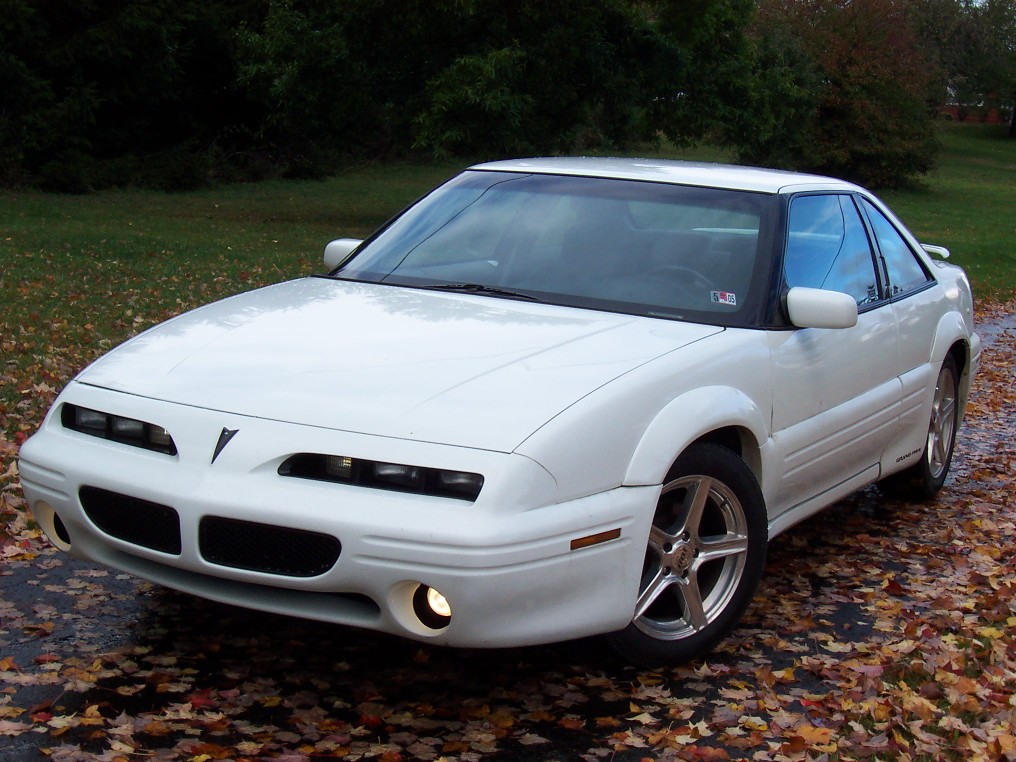
The sixth generation of the Pontiac Grand Prix lasted from 1988–1996. From 1988–1993 it retained the 2G designation, which switched to 2W in 1993. The 1996 Grand Prix was known as the Carline W internally. The 1988 Grand Prix now looked completely different, as the vehicle switched from the G-body to the first generation of the new W body.
Available trim levels were now the base, LE, and SE, as the Brougham was dropped. The Grand Prix still had the iconic split grille, wraparound tail lights, and was one of the most aerodynamic cars of the year. The front had MacPherson strut suspension with coil springs to allow for a lower hoodline. Disc brakes, halogen headlights, and rack-and-pinion steering were all standard.
In 1989, Y99 rally tuned suspension was available for the SE trim, as well as power windows and electronic controlled A/C. For this generation, the Pontiac Grand Prix was largely sold as a sporty coupe that could deliver solid performance and handling. From 1989–1990 there was a special turbo package, which was replaced in 1991 by the GT/GTP trim.
In 1990, the first Grand Prix sedan was available, marking the first non-coupe Grand Prix since the 1967 convertible. The performance package became the GT/GTP, which now had the Y99 rally suspension. In 1994, the GT/GTP became options rather than individual models, and the Grand Prix was only available as a SE coupe or sedan.
Sixth Generation Engines, Transmission Options, and Performance
| Model Years | Engine | Horsepower | Torque |
| 1988 | 2.8 L V6 | 130 horsepower | 160 lb-ft |
| 1989 | 2.8 L V6 | 130 horsepower | 170 lb-ft |
| 1989-1993 | 3.1 L V6 | 140 horsepower | 185 lb-ft |
| 1989-1990 | 3.1 L V6 (Turbo) | 205 horsepower | 220 lb-ft |
| 1990-1991 | 2.3 L I4 | 160 horsepower | 155 lb-ft |
| 1991-1996 | 3.4 L V6 | 210 horsepower | 215 lb-ft |
| 1994-1996 | 3.1 L V6 | 160 horsepower | 185 lb-ft |
Sixth Generation Engine Technical Specifications
The sixth generation of the Grand Prix would see the Grand Prix drop all V8s from the lineup until the mid-2000s. In its place were mainly V6s, though there was also an inline-four making 160 horsepower available from 1990-1991. All engines were now electronically fuel injected and no longer used carburetors.
Power output was pretty modest for most of the V6s, with the top dog being the short lived 3.1 L turbo from 1989–1990. It made 205 horsepower and 220 lb-ft of torque, marking the first 200+ horsepower Grand Prix since the 455 V8 from 1976. Succeeding the turbo V6 was a slightly larger naturally aspirated 3.4 L that made 210 horsepower and 215 lb-ft of torque.
Sixth Generation Pontiac Grand Prix Production Numbers
| Model Year | Bodystyle | Production Total |
| 1988 | Base/LE/SE Coupes | 86,357 |
| 1989 | Base/LE/SE Coupes | 136,747 |
| 1990 | LE/SE/SET/STE | 128,067 |
| 1991 | LE/SE/STE/GT/GTP | 114,718 |
| 1992 | LE/SE/STE/GT/GTP | 106,583 |
| 1993 | LE/SE/STE/GT | 106,083 |
| 1994 | SE | 148,405 |
| 1995 | SE | 143,729 |
| 1996 | SE | 83,587 |
| 1988-1996 | Total Production | 1,054,276 |
Production was relatively stable for the sixth generation of the Pontiac Grand Prix. The best years were 1989 and 1994–1995, but every single year except the bookends saw more than 106,000 cars produced. The Grand Prix was still one of the more popular Pontiacs on the market, slotting between the Firebird and Grand Am in terms of sales most years.
Seventh Generation Pontiac Grand Prix
The seventh and penultimate generation of the Pontiac Grand Prix lasted from 1997–2003. The same internal Carline W designation was kept for the entire series. Pontiac updated the W-body for 1997, giving it the famous Wide Track stance. It was two inches wider and three inches longer, with a low-profile roof, and inside had the brand new “cockpit” style interior.
For the 1997 Grand Prix, the SE and GT were the available trim options, with the SE sedan being the base model. In 1999, GT models got a rear spoiler. For 2002, there was an option package to celebrate the 40th Anniversary of the Grand Prix. This offered a new hood, spoiler, wheels, and a dual outlet exhaust with polished tips. 2002 was also the last year for the coupe, which had been in production since 1962.
There was a serious recall on the GTP models, as some engine compartments were prone to starting on fire, with over 230 reported. It only affected the supercharged versions, and was potentially due to faulty fuel-rail o-rings.
Seventh Generation Engines, Transmission Options, and Performance
| Model Years | Engine | Horsepower | Torque |
| 1997-2000 | 3.1 L V6 | 160 horsepower | 185 lb-ft |
| 1997-1998 | 3.8 L V6 | 195 horsepower | 220 lb-ft |
| 1997-2003 | 3.8 L V6 (Supercharged) | 240 horsepower | 280 lb-ft |
| 1999-2002 | 3.8 L V6 | 200 horsepower | 225 lb-ft |
| 2002-2003 | 3.1L V6 | 175 horsepower | 195 lb-ft |
Seventh Generation Engine Technical Specifications
The 1997 Pontiac Grand Prix carried over the 3.1 L V6, but two Buick Series 3800 (3.8 L) V6s were added. One was the naturally aspirated L36 Series II V6 at 195 horsepower, and the other was a supercharged L67 Series II V6 at 240 horsepower. The blower was an Eaton Gen III M90 roots-style. The naturally aspirated L36 got an update for 1999, that meant 5 horsepower and lb-ft of torque more.
Seventh Generation Pontiac Grand Prix Production Numbers
| Model Year | Bodystyle | Production Total |
| 1997 | SE/GT | 159,140 |
| 1998 | SE/GT | 142,346 |
| 1999 | SE/GT/GTP | 155,317 |
| 2000 | SE/GT/GTP | 172,811 |
| 2001 | SE/GT/GTP | 98,131 |
| 2002 | SE/GT/GTP | 160,543 |
| 1997-2002 | Total Production | 888,288 |
For the seventh generation Pontiac Grand Prix, production again remained relatively stable, outside of a one year dip in 2001. The Grand Prix was selling, and it was selling well. The high water mark came in 2000, with more than 172,000 sold. Overall production for the six-year cycle was just shy of 1 million, which was better per-year than the previous generation.
Eighth Generation Pontiac Grand Prix
The eighth and final generation of the Pontiac Grand Prix lasted from 2004–2008. It now resided on the third generation of the W-body, and trim levels were the GT1, GT2, GTP, and GTP Competition-G.
In 2005, Pontiac replaced the Comp-G option with a GXP option, featuring the new LS4 V8. The GXP package also had other features to improve handling and performance, which was required due to the massive torque steer from the 300 horsepower V8 in a front-wheel drive train.
The exterior of the Grand Prix did not change much for the final generation, though in 2006 there was a Special Edition with a new grille, diffuser, side skirts, and wheels. The GT trim was dropped in 2008, the last year of the Grand Prix.
Eighth Generation Engines, Transmission Options, and Performance
| Model Years | Engine | Horsepower | Torque |
| 2004-2008 | 3.8 L V6 | 200 horsepower | 230 lb-ft |
| 2004-2007 | 3.8 L V6 (Supercharged) | 260 horsepower | 280 lb-ft |
| 2005-2008 | 5.3 L V8 (LS4) | 303 horsepower | 323 lb-ft |
Eighth Generation Engine Technical Specifications
There were three engines available for the final eighth generation of the Pontiac Grand Prix. The two Series 3800 (3.8 L) V6s returned, one naturally aspirated and one supercharged. The naturally aspirated version was now the L26, while the supercharged version was the L32. The L32’s supercharger was improved to the Eaton Gen V M90. Power output increased on the L32, with the supercharged version now making 260 horsepower.
However, the top dog was now the 5.3 L LS4 V8 that made 303 horsepower and 323 lb-ft of torque. This was the first Grand Prix to reach above 300 horsepower since the 1971 455 V8 did so under SAE Gross horsepower ratings. At that point, the Grand Prix was still rear-wheel drive, and the switch to front-wheel drive created some problems.
The massive V8 was at first prone to torque steer in the Grand Prix, until the Pontiac engineers had a genius solution. They put thicker rubber in the front (255/45-18) vs the rear (225/50-18) to help control the power. It wasn’t a perfect solution, but was miles ahead of other FWD cars that suffered from torque steer (we’re looking at you Acura TL).
Pontiac Grand Prix Legacy
Though our younger readers might not be as familiar with it, the Grand Prix was one of the most stable and solid cars in the Pontiac lineup for more than four decades. It transformed from a full-sized personal luxury and muscle car, into a luxury coupe and sedan that ended with its muscle car roots intact.
On the way, Pontiac sold more than 4.2 million Grand Prix, a true sign of just how popular and reliable they are. There are still countless Grand Prix roaming the streets today, many of them still being driven by the original owner.
Unfortunately, the Grand Prix died with Pontiac in 2010, and will likely never be resurrected. Still, there is always the fond memory of Grand Prix from decades past, and at least those will hopefully last a long bit longer on the streets.
*Thank you to the Standard Catalog of Pontiac by John Gunnell for production figures and engine specifications.

